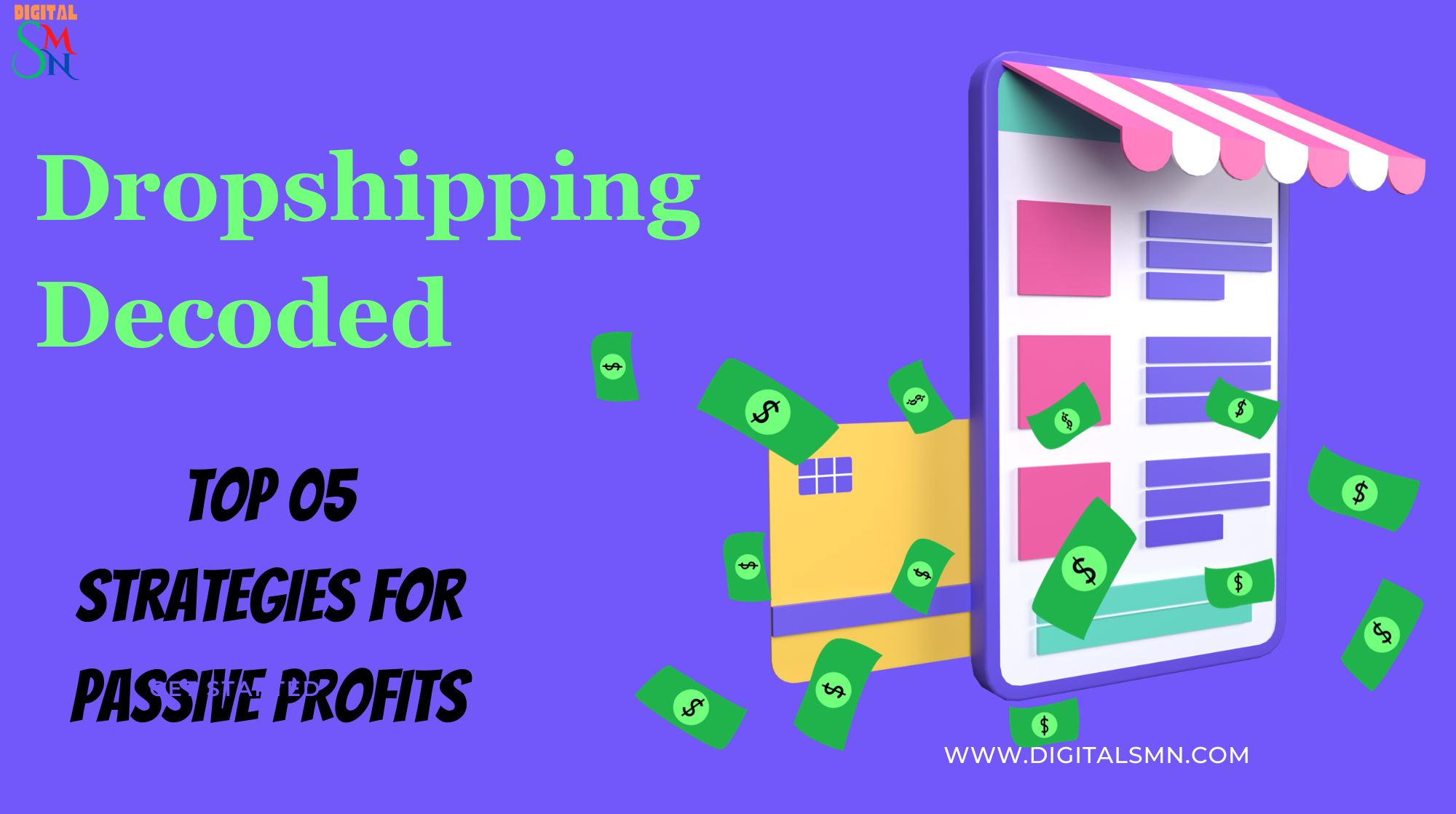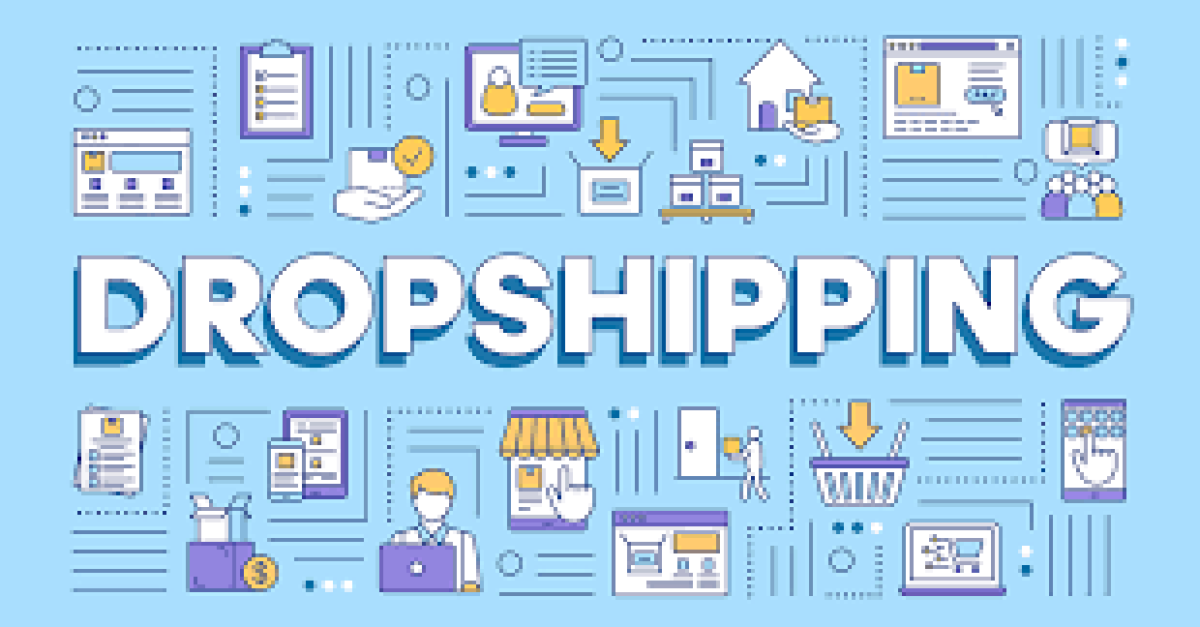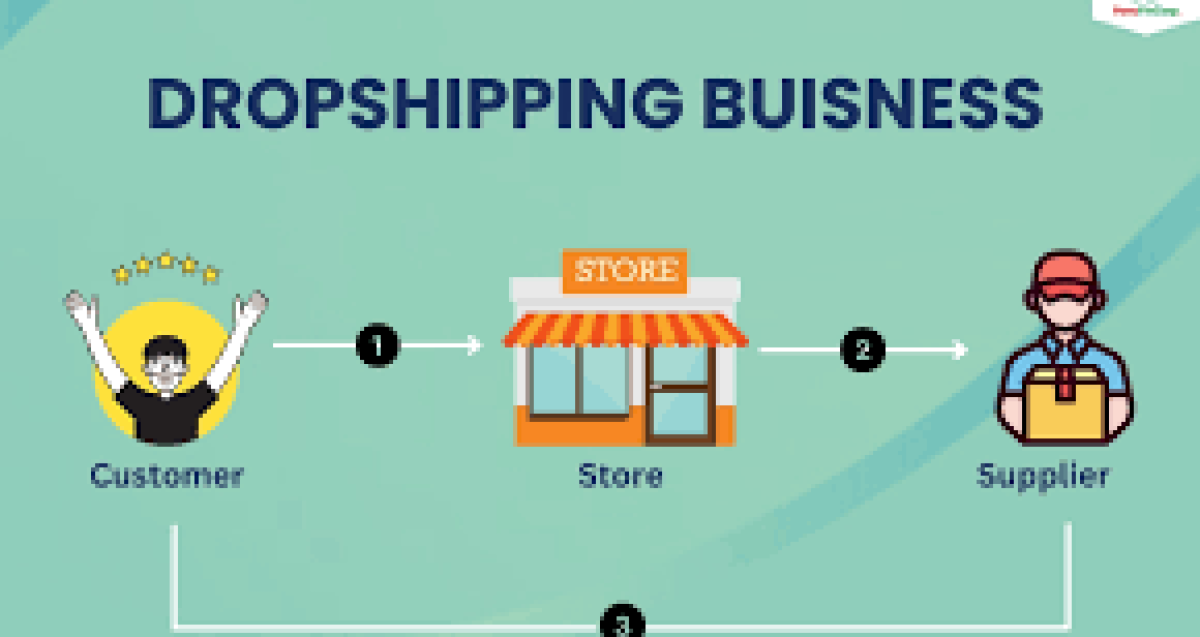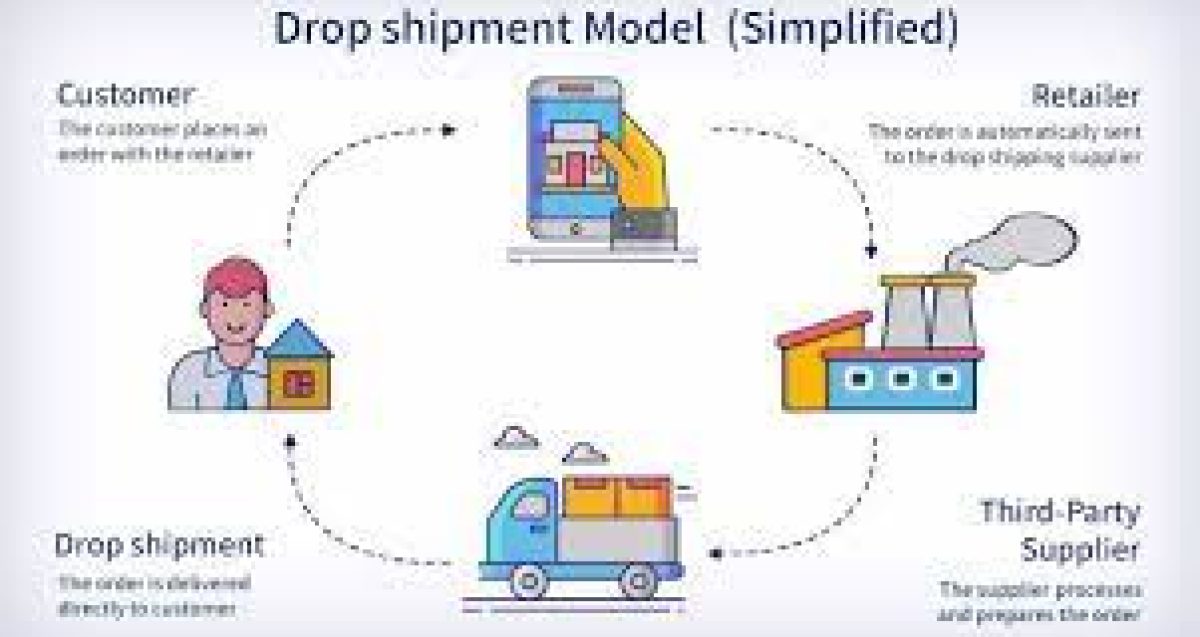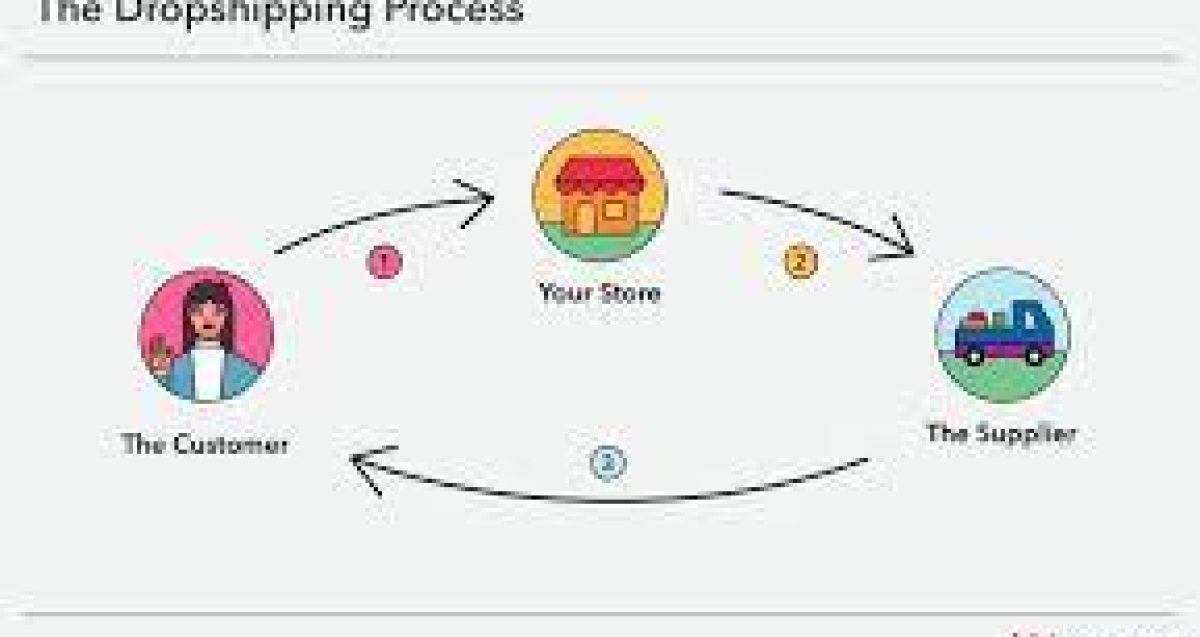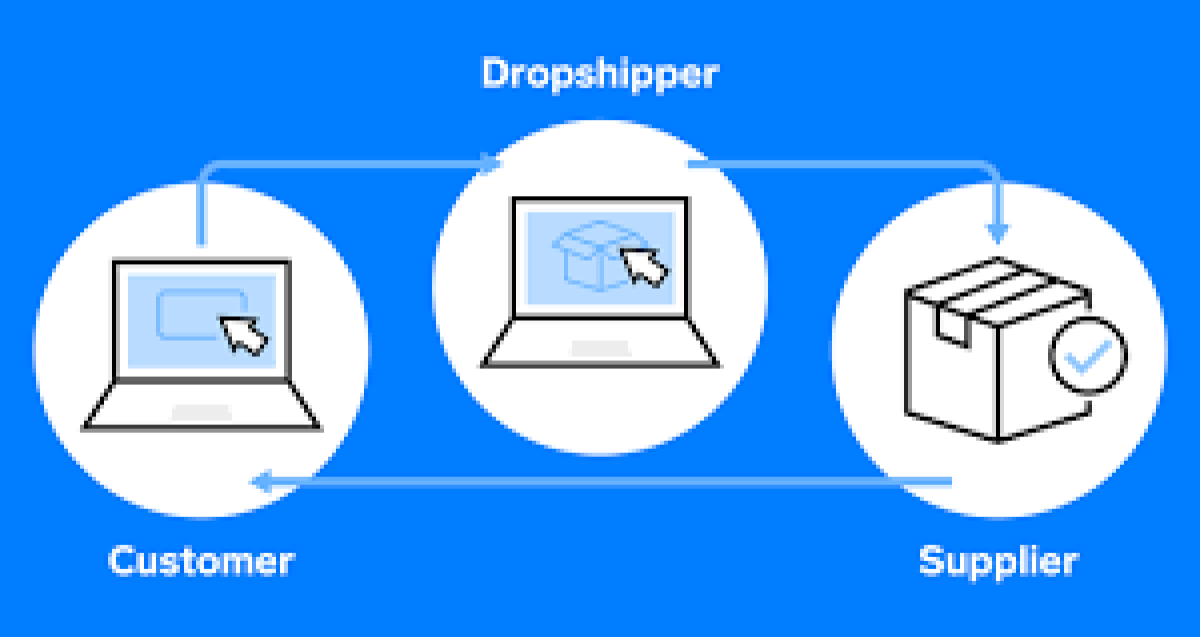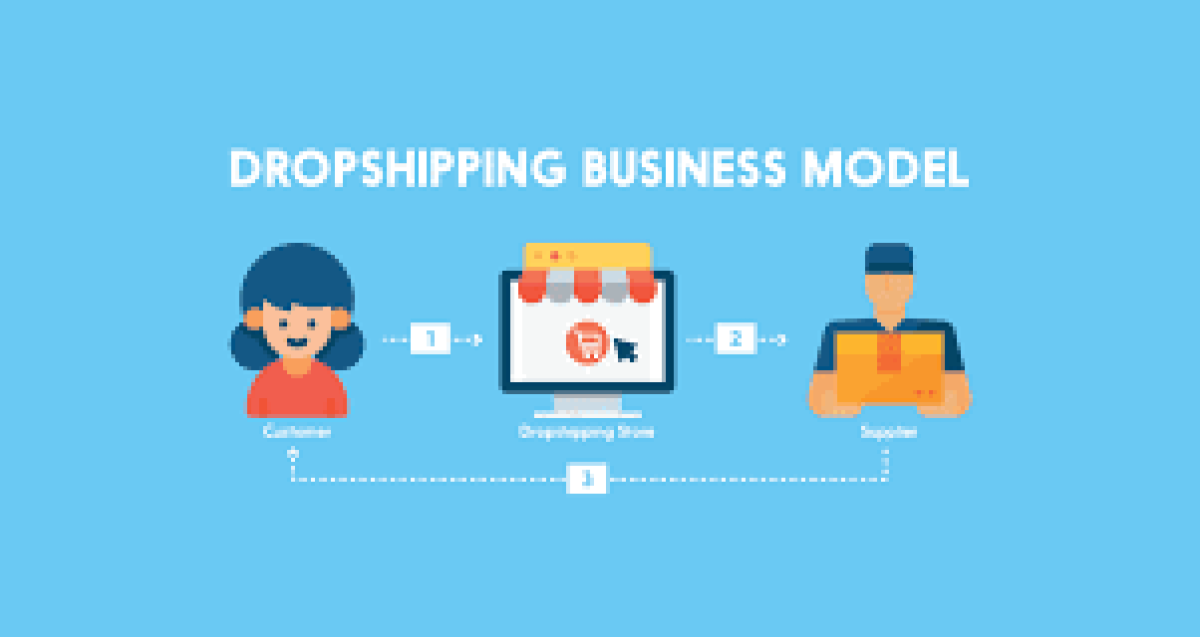In the ever-evolving landscape of e-commerce, dropshipping has emerged as a beacon for entrepreneurs seeking to embark on the journey of online retail with minimal upfront investment. This business model has redefined traditional notions of inventory management and order fulfillment, offering a gateway to passive profits and financial independence.
In this guide, we delve into the world of dropshipping, decoding its intricacies and unveiling the top five strategies that can pave the way for sustainable and passive income. Whether you’re a seasoned entrepreneur or someone exploring online business for the first time, understanding the core strategies of dropshipping is the key to navigating the complexities of this dynamic industry and turning it into a lucrative source of passive profits.
Join us as we unravel the secrets, strategies, and success stories that constitute the essence of dropshipping in today’s digital marketplace.
Table of Contents [hide]
- Introduction: Unveiling the World of Dropshipping
- Understanding Dropshipping: A Seamless Order Fulfillment Model
- Choosing Profitable Niches: The Foundation of Dropshipping Success
- Optimizing Product Sourcing: Key to a Profitable Dropshipping Business
- Crafting a Winning Marketing Strategy: Driving Traffic and Sales
- Customer Service Excellence: Building Trust for Long-Term Success
- Conclusion: Navigating the Future of Dropshipping
Introduction: Unveiling the World of Dropshipping
Welcome to the realm of Dropshipping, a dynamic and innovative business model that has transformed the landscape of e-commerce. As we delve into this introductory chapter, imagine stepping into a world where traditional inventory hassles are replaced with a seamless and efficient order fulfillment process.
Dropshipping, in essence, is a retail fulfillment method where a store doesn’t keep the products it sells in stock. Instead, when you sell a product, you purchase the item from a third party and have it shipped directly to the customer.
The allure of dropshipping lies in its simplicity. Unlike conventional retail models, you, as a dropshipper, don’t have to deal with the complexities of managing inventory, warehouse space, or the cost of unsold goods. This opens up a world of possibilities for aspiring entrepreneurs and business enthusiasts to enter the e-commerce space without the traditional barriers.
To understand dropshipping comprehensively, let’s explore its fundamental principles and the key players involved in this innovative supply chain strategy. As we embark on this journey, we’ll draw insights from industry leaders, e-commerce platforms, and success stories that highlight the potential and impact of dropshipping in today’s fast-paced digital economy.
Whether you’re a budding entrepreneur looking to start your first online venture or an experienced business owner seeking to diversify revenue streams, the world of dropshipping offers a wealth of opportunities. So, fasten your seatbelt as we unravel the layers of dropshipping, uncovering the strategies, benefits, and challenges that come with this exciting e-commerce adventure.
Read Our Product Review Here
Understanding Dropshipping: A Seamless Order Fulfillment Model
Welcome to the heart of dropshipping, a business model that epitomizes the art of seamless order fulfillment. As we navigate through the intricate details of dropshipping, envision a business environment where you can offer a plethora of products without the burden of managing inventory or dealing with logistical nightmares. Dropshipping is more than just a retail strategy; it’s a paradigm shift that empowers entrepreneurs to thrive in the competitive realm of e-commerce.
1. Understanding the Essence of Dropshipping
At its core, dropshipping is a retail fulfillment method that simplifies the supply chain process. Traditionally, a retailer purchases inventory in bulk, stores it, and then ships it to customers. Dropshipping, however, redefines this process. When a product is sold, the retailer buys the item from a third-party supplier who ships it directly to the customer. This unique model eliminates the need for a physical storefront or extensive warehouse space, making it an attractive proposition for those looking to venture into e-commerce without substantial capital.
2. Navigating the Dropshipping Supply Chain
Imagine being the orchestrator of a virtual storefront where you curate a catalog of products without the need to physically handle each item. The supply chain in dropshipping is a well-choreographed dance involving you, the retailer, and suppliers. Platforms like AliExpress, Oberlo, and SaleHoo connect you with a vast network of suppliers, often based in countries with lower manufacturing costs. This direct connection allows you to showcase a diverse range of products, all without the headaches of inventory management.
3. Embracing Technological Integration
One of the hallmarks of successful dropshipping is the integration of technology. Platforms like Shopify and WooCommerce provide intuitive interfaces for setting up and managing your online store. These platforms seamlessly integrate with dropshipping tools, automating various aspects of the business, from order processing to shipment tracking. This technological synergy ensures that you can focus on growing your business instead of getting bogged down by operational complexities.
4. The Role of E-commerce Platforms
E-commerce giants like Amazon and eBay have played a pivotal role in popularizing dropshipping. Leveraging the vast user base and robust infrastructure of these platforms, dropshippers can reach a global audience with minimal effort. Amazon’s FBA (Fulfillment by Amazon) program, for instance, extends the benefits of dropshipping by handling the storage, packing, and shipping of products. This strategic partnership between dropshippers and e-commerce behemoths exemplifies the symbiotic relationship that defines the modern digital marketplace.
5. Challenges and Pitfalls
While dropshipping presents an enticing prospect, it’s not without its challenges. Delivery times, product quality, and reliance on third-party suppliers are common hurdles. Navigating the fine line between profit margins and competitive pricing requires strategic acumen. It’s crucial to acknowledge these challenges and approach dropshipping with a realistic mindset, understanding that success is often a result of overcoming obstacles.
6. Success Stories and Inspirations
No exploration of dropshipping would be complete without delving into success stories. Platforms like Shopify showcase tales of entrepreneurs who started small but, through strategic product selection, marketing, and customer engagement, built thriving dropshipping empires. These stories serve as both motivation and valuable lessons, emphasizing the importance of adaptability and continuous learning in the dynamic world of e-commerce.
As we unravel the layers of dropshipping, it becomes evident that this business model is more than a transactional approach to retail; it’s a dynamic ecosystem where innovation, technology, and strategic partnerships converge to redefine the traditional retail landscape. So, join me as we delve deeper into the nuances of dropshipping, exploring strategies, success stories, and the transformative power of this seamless order fulfillment model.
Read Our Product Review Here
Choosing Profitable Niches: The Foundation of Dropshipping Success
Welcome to the exciting world of dropshipping, where the choice of a niche is not just a decision but a cornerstone that can define the trajectory of your success. As we embark on this journey, envision yourself as a savvy entrepreneur navigating the vast landscape of e-commerce, seeking the perfect niche to carve your niche in. Choosing a profitable niche is akin to selecting the right soil for a seed; it’s the foundation on which the entire venture rests.
1. Understanding the Significance of Niche Selection
In the vast expanse of online retail, not all products are created equal. The concept of a niche revolves around finding a specialized segment of the market with specific needs, preferences, and demands. A niche is not merely a category; it’s a carefully curated space where your products can stand out amidst the digital cacophony. The right niche sets the stage for targeted marketing, efficient customer acquisition, and, ultimately, profitability.
2. Analyzing Market Trends and Demand
The first step in selecting a profitable niche is to delve into market trends and consumer demand. Tools like Google Trends, Amazon Best Sellers, and social media analytics become your compass, guiding you towards areas of consumer interest. Analyzing trends provides insights into products that are gaining traction, helping you identify niches with growing demand.
3. Leveraging E-commerce Platforms for Insights
E-commerce platforms themselves offer a wealth of information to aid in niche selection. Amazon, for instance, provides data on the best-selling products in various categories. Exploring these platforms not only reveals current market trends but also sheds light on gaps and opportunities within niches. It’s a treasure trove of information waiting to be mined.
4. Researching Competitor Strategies
Competition is a reality in the world of dropshipping, but it can also be a source of valuable insights. Analyzing the strategies of successful competitors in potential niches can unveil tactics that work and those that don’t. Tools like Ahrefs and SEMrush empower you to peek behind the curtain, understanding competitor keywords, traffic sources, and overall market positioning.
5. Assessing Profit Margins and Feasibility
While passion for a niche is crucial, financial viability cannot be overlooked. It’s essential to evaluate the profit margins of products within a niche, factoring in the cost of goods, shipping, and potential marketing expenses. Platforms like Oberlo and SaleHoo provide estimates of product costs and market prices, aiding in the assessment of a niche’s feasibility.
6. Target Audience Identification
A profitable niche isn’t just about the product; it’s about connecting with a specific audience. Clearly defining your target demographic – their preferences, pain points, and online behavior – allows you to tailor your marketing efforts effectively. Tools like Facebook Audience Insights can provide valuable demographic data, helping you align your niche with the right audience.
7. Evergreen Niches vs. Trending Niches
Another consideration in niche selection is whether to opt for evergreen niches or trending ones. Evergreen niches, such as health and wellness, maintain consistent demand over time. Trending niches, on the other hand, capitalize on current fads. Striking the right balance between the two can contribute to sustained success.
As we navigate the process of choosing profitable niches for dropshipping, remember that this decision is not set in stone. Adaptability and a willingness to iterate based on market dynamics are key. So, join me in exploring the art and science of niche selection, where each decision shapes the trajectory of your dropshipping journey.
Read Our Product Review Here
Optimizing Product Sourcing: Key to a Profitable Dropshipping Business
In the realm of dropshipping, the optimization of product sourcing emerges as a pivotal element, akin to the finely tuned engine of a high-performance vehicle. As we embark on the journey of understanding the nuances of product sourcing, envision yourself as a discerning entrepreneur meticulously curating a selection of products that not only captivate your audience but also contribute to the profitability and sustainability of your dropshipping business.
1. The Dynamics of Product Sourcing in Dropshipping
Navigating the intricate landscape of product sourcing in dropshipping requires an understanding of the diverse methods and platforms available. Dropshipping, by nature, involves the retailer (you) partnering with suppliers who handle the fulfillment and shipping processes. Platforms like AliExpress, Oberlo, and SaleHoo serve as gateways to a multitude of products, connecting dropshippers with suppliers across the globe.
2. AliExpress: A Global Marketplace for Dropshipping
As a dropshipper, AliExpress stands out as a juggernaut in the world of product sourcing. With millions of products from a plethora of categories, AliExpress provides an extensive array of options for dropshippers. Its user-friendly interface, buyer protection policies, and the ability to connect directly with suppliers make it a go-to platform. However, diligent research and scrutiny of suppliers are essential to ensure product quality and timely shipping.
3. Oberlo Integration with Shopify: Streamlining Dropshipping
For those embarking on the dropshipping journey through Shopify, Oberlo offers seamless integration. This platform allows you to import products directly into your Shopify store, simplifying the process of managing inventory, product descriptions, and order fulfillment. With Oberlo, the synergy between product sourcing and your online store becomes a fluid, automated process.
4. SaleHoo: A Directory of Vetted Suppliers
In the vast ocean of dropshipping, finding reliable suppliers is akin to discovering hidden treasures. SaleHoo serves as a directory of vetted suppliers, offering a curated list that has undergone thorough scrutiny. This ensures a higher level of confidence in the reliability of suppliers, mitigating risks associated with product quality and shipping delays.
5. Diversification and Niche-Focused Sourcing
Optimizing product sourcing isn’t just about finding any product; it’s about aligning your offerings with your niche and target audience. Diversification, both in product types and suppliers, adds resilience to your dropshipping business. Niche-focused sourcing involves selecting products tailored to the specific interests and needs of your audience, enhancing the appeal and relevance of your offerings.
6. Quality Assurance and Supplier Communication
Ensuring the quality of products is paramount in dropshipping. Establishing clear communication channels with suppliers helps in understanding their processes, quality control measures, and shipping times. Tools like communication templates and regular check-ins contribute to a transparent and collaborative relationship, reducing the likelihood of misunderstandings.
7. Balancing Cost and Quality
The delicate balance between cost-effectiveness and product quality defines the success of your dropshipping venture. While seeking affordable products is essential, compromising on quality can lead to customer dissatisfaction and negative reviews. Striking the right balance involves meticulous research, negotiation with suppliers, and continuous evaluation of product performance.
8. Leveraging Data for Informed Sourcing Decisions
In the age of data, leveraging analytics becomes a powerful tool in optimizing product sourcing. Analyzing data on product performance, customer feedback, and market trends guides informed decisions. Tools like Google Analytics, Shopify Analytics, and customer surveys contribute valuable insights, enabling you to refine your product selection strategy.
As we delve into the intricacies of optimizing product sourcing in dropshipping, remember that this journey is dynamic. The ebb and flow of market trends, customer preferences, and emerging technologies necessitate a continuous adaptation and optimization process. Join me in navigating the evolving landscape of product sourcing, where each decision contributes to the resilience and profitability of your dropshipping enterprise.
Read Our Product Review Here
Crafting a Winning Marketing Strategy: Driving Traffic and Sales
In the realm of dropshipping, crafting a winning marketing strategy emerges as the linchpin that propels your venture from obscurity to prominence. Imagine standing at the helm of your dropshipping enterprise, armed with a nuanced understanding of the digital marketing landscape. As we embark on the journey of unraveling the intricacies of a winning marketing strategy, picture yourself as the architect, designing a blueprint that not only drives traffic but also converts visitors into loyal customers, fostering sustainable growth for your dropshipping business.
1. The Foundations of Dropshipping Marketing
Begin our exploration by laying the foundations of a robust marketing strategy. In the dynamic world of e-commerce, digital marketing serves as the cornerstone for visibility and brand awareness. Platforms like Facebook, Instagram, Google Ads, and influencer marketing play pivotal roles in amplifying your reach. Understanding your target audience, their behaviors, and the platforms they frequent allows for a strategic approach.
2. Facebook Ads: Targeted Advertising at Scale
Navigate the vast landscape of digital advertising with Facebook Ads, a powerhouse for dropshippers. The platform’s granular targeting options enable you to pinpoint your ideal audience based on demographics, interests, and online behaviors. With a compelling ad copy and eye-catching visuals, Facebook Ads can drive traffic and conversions. Stay attuned to ad performance metrics and adjust your strategy accordingly.
3. Instagram Influencer Marketing: Harnessing Social Influence
Imagine collaborating with influencers who resonate with your brand. Instagram, with its visually driven nature, is a hub for influencer marketing. Identify influencers aligned with your niche, and leverage their engaged audience. The authenticity of influencer endorsements can enhance brand credibility and drive traffic to your dropshipping store. Tools like Influencity and Hootsuite can aid in influencer discovery and campaign management.
4. Google Ads: Precision in Search Advertising
Embark on a journey into the world of search advertising with Google Ads. Capitalize on the intent-driven nature of Google searches by placing your products at the forefront. Employ keyword research to optimize your ad targeting, ensuring your products appear when potential customers are actively seeking them. Google Ads offers a versatile platform, encompassing search, display, and video advertising.
5. Content Marketing: Storytelling for Engagement
Imagine crafting compelling narratives that not only showcase your products but also resonate with your audience on a deeper level. Content marketing, in the form of blog posts, videos, and social media content, fosters a connection with your audience. Platforms like Shopify and WordPress facilitate the creation of engaging blog content, while video content on YouTube can provide tutorials, reviews, and behind-the-scenes glimpses.
6. Email Marketing: Nurturing Customer Relationships
Picture a scenario where you nurture relationships with your customers beyond the initial transaction. Email marketing serves as the conduit for ongoing communication. Build an email list through opt-ins on your website and employ automation tools like Mailchimp or Klaviyo to send targeted campaigns. From newsletters to exclusive offers, email marketing keeps your brand top-of-mind for repeat business.
7. Retargeting Strategies: Bringing Back Lost Opportunities
Visualize a scenario where potential customers who visited your site but didn’t make a purchase are gently guided back. Retargeting employs ads that reappear to users who have interacted with your site. Platforms like AdRoll and Google Ads offer retargeting options. Implementing this strategy capitalizes on the familiarity users have with your brand, increasing the likelihood of conversion.
8. Data-Driven Decision Making: Analytics for Optimization
Envision a scenario where each marketing decision is backed by data and insights. Google Analytics, Shopify Analytics, and Facebook Insights provide a treasure trove of information. Analyze user behavior, conversion rates, and the effectiveness of different marketing channels. These analytics tools empower you to refine your strategy continuously, focusing on what works best for your dropshipping business.
9. Leveraging User-Generated Content: Turning Customers into Advocates
Imagine your customers becoming enthusiastic advocates for your brand. Encourage user-generated content (UGC) by showcasing customer reviews, testimonials, and photos. Platforms like Yotpo and Loox facilitate the collection and display of UGC. Authentic content from satisfied customers serves as social proof, instilling confidence in potential buyers.
10. TikTok Marketing: Riding the Wave of Short-Form Video
As we conclude our exploration, envision riding the wave of TikTok’s explosive popularity. This platform, driven by short-form videos, presents an opportunity for creative marketing. Explore trends, collaborate with influencers, and showcase your products in engaging ways. TikTok’s algorithm can rapidly expose your brand to a broad audience.
In this dynamic journey of crafting a winning marketing strategy for dropshipping, each channel and tactic serves as a brushstroke on the canvas of your brand’s narrative. As the architect of your marketing blueprint, adaptability and creativity become your guiding principles. Let the data inform your decisions, the trends inspire your innovations, and the customer journey shape your success in the dropshipping arena.
Read Our Product Review Here
Customer Service Excellence: Building Trust for Long-Term Success
Embarking on the realm of dropshipping, I am keenly aware that customer service excellence is the bedrock upon which long-term success is built. Picture this: as a dropshipper, the entire transactional experience hinges on virtual interactions. It’s not merely about selling products; it’s about delivering an unparalleled customer experience that transcends the limitations of a digital storefront. Let’s delve into the nuanced landscape of customer service in dropshipping, exploring strategies, tools, and industry insights that contribute to building trust and fostering lasting success.
1. The Significance of Customer Service in Dropshipping
As the architect of my dropshipping venture, I recognize that customer service isn’t a mere transactional formality—it’s the heartbeat of my business. Platforms like Shopify emphasize the importance of establishing strong customer relationships, asserting that exceptional service transforms first-time buyers into loyal patrons.
2. The Role of Live Chat: Real-Time Support for Instant Gratification
Imagine this scenario: a potential customer perusing my dropshipping store encounters a query. Swift resolution is paramount, and that’s where live chat becomes a game-changer. Integrating tools like Tidio or LiveChat facilitates real-time communication, addressing concerns promptly and elevating the overall customer experience.
3. AI-Powered Customer Support: Efficiency and Personalization
Acknowledging the evolving landscape of customer service, I am intrigued by the integration of artificial intelligence. AI-driven tools, such as chatbots powered by platforms like Drift or Intercom, offer instant responses, streamline queries, and provide a personalized touch. This not only enhances efficiency but also showcases a commitment to embracing cutting-edge solutions.
4. Email Support: Crafting Thoughtful Responses for Lasting Impressions
In the digital dialogue between my dropshipping business and customers, email support is a pivotal player. Picture crafting thoughtful and comprehensive responses that go beyond addressing concerns—they elevate the customer experience. Tools like Zendesk or Help Scout assist in managing email inquiries efficiently, ensuring no query goes unanswered.
5. Phone Support: A Human Touch in the Digital Realm
While the digital landscape prevails, I recognize the enduring power of human connection. Implementing phone support, facilitated by platforms like RingCentral or Grasshopper, offers customers a direct line of communication. This personal touch resonates, fostering trust and leaving a lasting impression.
6. Social Media Customer Service: Meeting Customers Where They Are
In the interconnected world of social media, I envision providing customer service on platforms like Facebook, Instagram, and Twitter. Tools like Hootsuite or Sprout Social can streamline social interactions, enabling me to address concerns, express gratitude for positive feedback, and showcase the human side of my dropshipping brand.
7. Returns and Refunds: Transparent Policies for Trust Building
In the conversation of customer service excellence, addressing returns and refunds transparently is non-negotiable. Platforms like Returnly or Loop can streamline this process, ensuring that customers feel confident in their purchase, even when contingencies arise.
8. Community Building: Transforming Customers into Brand Advocates
As I chart my course in dropshipping, I am cognizant of the power of community building. Platforms like Yotpo facilitate the collection of customer reviews and testimonials, transforming satisfied buyers into vocal brand advocates. Leveraging this user-generated content not only builds trust but also fuels organic growth.
9. Continuous Improvement: Listening to Customer Feedback
In the spirit of a continual evolution, I commit to listening attentively to customer feedback. Platforms like Trustpilot or Feefo offer spaces for customers to share their experiences openly. This feedback loop becomes a valuable tool, guiding improvements and showcasing a commitment to excellence.
10. Industry Insights: Learning from Success Stories and Challenges
As I navigate the intricacies of dropshipping customer service, I tap into industry insights from reputable sources. Recognized publications like Shopify’s blog or EcommerceFuel provide a wealth of information, offering success stories, challenges, and emerging trends that inform my approach.
In this immersive journey of dropshipping, customer service isn’t a compartmentalized function—it’s a narrative that unfolds with each interaction. It’s about not just meeting but exceeding expectations. It’s about transparency, empathy, and a commitment to continuous improvement. As I envision the success of my dropshipping venture, I understand that customer service excellence is the conduit that transforms one-time buyers into lifelong patrons, laying the foundation for enduring success in the dynamic landscape of e-commerce.
Read Our Product Review Here
Conclusion: Navigating the Future of Dropshipping
As I stand at the crossroads of this dropshipping journey, the landscape ahead is both promising and dynamic. The conclusion isn’t an endpoint but a juncture where reflections and foresight converge. With the echo of every transaction and the resonance of customer interactions, I’ve gained profound insights into the world of dropshipping. Let’s navigate the future of dropshipping together, incorporating learnings from industry leaders, emerging trends, and the ever-evolving dynamics of e-commerce.
1. The Ever-Evolving E-commerce Ecosystem
In steering my dropshipping venture towards the future, I acknowledge the fluidity of the e-commerce ecosystem. Platforms like Oberlo and Spocket continue to adapt to market changes, offering insights into trending products, efficient order fulfillment, and the pulse of consumer demand. Staying attuned to these platforms positions me at the forefront of an evolving landscape.
2. Sustainable Practices: A Paradigm Shift in Dropshipping
As sustainability becomes a cornerstone of consumer choices, I am compelled to weave eco-conscious practices into my dropshipping strategy. Platforms like Printify and Printful, with their emphasis on sustainable sourcing and responsible manufacturing, inspire a shift towards ethical and environmentally friendly dropshipping models.
3. Diversification: Expanding Product Offerings for Market Resilience
In mapping out the trajectory of my dropshipping business, the concept of diversification becomes a compass. Insights from marketplaces like Alibaba and SaleHoo reveal a vast array of products, allowing me to expand beyond a niche and cater to diverse consumer preferences. Diversification isn’t just a strategy; it’s a response to the evolving tastes of a dynamic market.
4. Integration of Augmented Reality: Enhancing the Online Shopping Experience
The future of dropshipping is intertwined with technological advancements. Exploring platforms like Shopify, which integrates augmented reality (AR) for immersive shopping experiences, propels my venture into a realm where customers can virtually interact with products before making a purchase. It’s not just about products; it’s about crafting experiences.
5. Data-Driven Decision-Making: Insights from Analytics Platforms
As I peer into the future, the role of data assumes paramount importance. Analytics platforms such as Google Analytics and Hotjar provide nuanced insights into customer behavior, website performance, and the efficacy of marketing strategies. Armed with this data, I navigate the future with informed decisions, optimizing every aspect of my dropshipping business.
6. Cryptocurrency Integration: Embracing the Currency of the Future
In contemplating the trajectory of e-commerce, the integration of cryptocurrencies emerges as a futuristic consideration. Exploring platforms like BitPay opens avenues for accepting cryptocurrency payments, tapping into a burgeoning market and aligning my dropshipping business with the digital currencies shaping the financial landscape.
7. Cross-Border Expansion: Tapping into Global Markets
The future of dropshipping isn’t confined by borders. Platforms like ShipBob and ShipStation empower me to explore international markets seamlessly. Navigating customs regulations, understanding global shipping logistics, and tailoring my marketing approach to diverse audiences become pivotal steps in expanding the footprint of my dropshipping venture.
8. Micro-Influencer Collaborations: Humanizing the Brand
In envisioning the path ahead, the influence of individuals gains prominence. Platforms like AspireIQ and Traackr facilitate collaborations with micro-influencers, enabling me to humanize my brand and connect authentically with niche audiences. It’s a departure from traditional marketing, embracing the power of personal connections in the digital realm.
9. Customer Retention Strategies: Fostering Loyalty in the Digital Age
As I traverse the future of dropshipping, the spotlight on customer retention becomes brighter. Platforms like Smile.io and Yotpo offer insights into crafting loyalty programs, leveraging customer reviews, and creating a community around my brand. It’s not just about acquiring customers; it’s about nurturing relationships that withstand the test of time.
10. Adapting to Regulatory Changes: Navigating Compliance Challenges
The regulatory landscape of e-commerce is subject to evolution. Platforms like LegalZoom provide resources to navigate legalities, ensuring that my dropshipping venture aligns with changing regulations. As I forge ahead, staying abreast of compliance requirements becomes an integral part of sustained success.
In this culmination of reflections and forward-looking insights, the future of dropshipping isn’t a distant horizon; it’s a canvas waiting to be painted. It’s about adapting, innovating, and embracing the transformative currents of e-commerce. As I embark on this ongoing journey, informed by the collective wisdom of industry platforms, emerging technologies, and the evolving expectations of consumers, I step into the future of dropshipping with resilience, vision, and an unwavering commitment to crafting a success story in the dynamic tapestry of online commerce.

